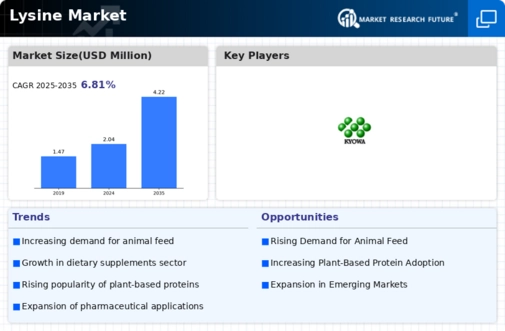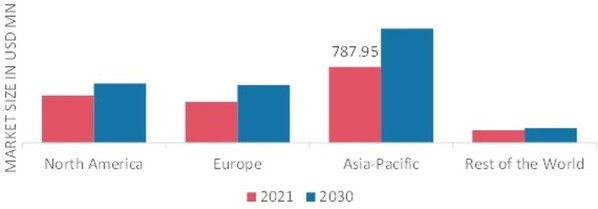Market Share
Introduction: Navigating Competitive Dynamics in the Lysine Market
Lysine is undergoing a process of change. There are a number of established companies and a number of newcomers, from biotechnologically oriented start-ups to traditional petrochemical companies, all of which are trying to establish themselves in the market with a differentiated strategy. The established companies are concentrating on automation and the Internet of Things to increase the efficiency of their production. The newcomers are concentrating on green supply chains and artificial intelligence to optimize their logistics and meet regulatory requirements. Also, there are opportunities for growth in Asia-Pacific and Latin America, where livestock farming is developing and dietary changes are pushing up demand. The strategic trends for 2024 and 2025 will be dominated by the establishment of strategic alliances and investments in R & D, which will lead to the formation of a new competitive landscape and the positioning of the companies in the lysine market.
Competitive Positioning
Full-Suite Integrators
These vendors offer comprehensive solutions across the lysine production process, leveraging extensive resources and capabilities.
| Vendor | Competitive Edge | Solution Focus | Regional Focus |
|---|---|---|---|
| Evonik Industries | Strong R&D and innovation capabilities | Lysine production and derivatives | Global |
| Ajinomoto Co. Ltd. | Leading in amino acid production | Amino acids and lysine | Asia, Americas, Europe |
| Archer Daniel Midland (ADM) | Diverse agricultural supply chain | Lysine and feed additives | North America, South America |
Specialized Technology Vendors
These companies focus on specific technologies or processes that enhance lysine production efficiency and quality.
| Vendor | Competitive Edge | Solution Focus | Regional Focus |
|---|---|---|---|
| Cheil Jedang Corp | Advanced fermentation technology | Fermented lysine products | Asia, Americas |
| Bio-Chem Technology Group Company Limited | Innovative bioprocessing techniques | Biotechnology for lysine production | Asia |
| COFCO Biochemical (Anhui) Co. Ltd. | Integration with agricultural resources | Lysine and biochemical products | China |
Infrastructure & Equipment Providers
These vendors supply the necessary infrastructure and equipment for lysine production, supporting operational efficiency.
| Vendor | Competitive Edge | Solution Focus | Regional Focus |
|---|---|---|---|
| Shandong Shaouguang Juneng Golden Corn Co. Ltd. | Strong corn processing capabilities | Lysine from corn fermentation | China |
| Changchun Dacheng Group | Established production facilities | Lysine and feed additives | China |
| Sunrise Nutrachem Group | Focus on nutritional products | Nutritional lysine solutions | Asia, Americas |
| KYOWA HAKKO BIO CO. LTD. | Expertise in amino acid fermentation | Amino acids including lysine | Global |
Emerging Players & Regional Champions
- CJ CheilJedang (South Korea): Leading producer of lysine with a focus on fermentation technology, recently expanded production capacity in Southeast Asia, challenging established players like ADM with lower production costs and sustainable practices.
- Evonik Industries (Germany) – specialized in the manufacture of lysine for animal nutrition, it has recently signed contracts with the largest feed manufacturers in Europe and is positioned as a premium supplier, complementing the traditional suppliers through quality and performance.
- Ajinomoto (Japan): Known for its amino acid production, Ajinomoto has launched a new line of lysine products tailored for organic farming, which challenges conventional suppliers by tapping into the growing organic market segment.
- A Chinese company, the Global Bio-Chemical Technology Group, specializes in the production of bio-lysine. It has established a long-term cooperative relationship with a major livestock feed company in China. By providing a cost-effective alternative to synthetic lysine, it is threatening the established chemical companies.
Regional Trends: In Asia-Pacific, lysine production is growing rapidly. The growing demand for animal protein and the improvement of fermentation technology are the main driving forces. There is a noticeable shift towards sustainable and organic production. The new players are focusing on bio-based solutions. Regional champions are also forming local alliances to improve their market penetration and distribution. The established players are responding to these developments by improving their product offerings.
Collaborations & M&A Movements
- Cargill and ADM announced a joint venture to enhance lysine production efficiency, aiming to capture a larger share of the growing animal nutrition market in North America.
- Evonik Industries acquired a minority stake in a biotech startup focused on sustainable lysine production, positioning itself as a leader in environmentally friendly amino acid solutions.
- Ajinomoto and DSM entered into a strategic partnership to develop innovative lysine formulations for the aquaculture sector, enhancing their competitive positioning in the rapidly expanding seafood market.
Competitive Summary Table
| Capability | Leading Players | Remarks |
|---|---|---|
| Production Efficiency | Ajinomoto, Evonik, CJ CheilJedang | Evonik is concentrating on automation to optimize its production processes, while Ajinomoto is using the most advanced fermentation technology to increase the yield. CJ Cheil Jedang is using a closed-loop system to reduce waste and prove its commitment to the environment. |
| Sustainability Practices | Archer Daniels Midland, BASF, Nutreco | The investment in the production of energy from renewable sources is reducing the company's carbon footprint. It is reducing its reliance on fossil fuels. It is also developing initiatives to promote responsible animal nutrition, in line with the UN's sustainable development goals. |
| Product Innovation | Ajinomoto, Evonik, CJ CheilJedang | Ajinomoto has developed a range of high-quality lysine products designed to meet the needs of various animal diets. Evonik has introduced lysine formulations that optimize the use of feed. Cheil Jedang has been investing in research and development to create lysine products that meet the changing needs of the market. |
| Market Reach | BASF, Archer Daniels Midland, Evonik | Having a strong worldwide distribution network, BASF can offer its products all over the world. Archer Daniels Midland uses its strong logistics to penetrate emerging markets, while Evonik uses its local partners to expand its market presence. |
| Customer Support and Service | Nutreco, Ajinomoto, CJ CheilJedang | In addition, Nutreco provides full technical support to optimize the formulations. Ajinomoto offers a complete package of products and services, including training. CJ Cheil Jedang has established a feedback system to ensure a continuous improvement in the service. |
Conclusion: Navigating the Competitive Lysine Landscape
Lysine 2024 is characterized by high competition and significant fragmentation, with the competition between the old and new players being particularly intense. The regional trends point to Asia-Pacific as a key growth area, which means that the suppliers have to adjust their strategies accordingly. Old players are able to rely on established distribution channels and brand loyalty, while new companies can rely on innovation and sustainability to capture the attention of consumers with an increased awareness of the environment. The future market leaders will be able to rely on artificial intelligence-driven analysis, automation in the production process, and a focus on sustainability. To maintain a competitive edge, the suppliers must be flexible and able to respond quickly to changes in the market.


 Source: Secondary Research, Primary Research, Market Research Future Database and Analyst Review
Source: Secondary Research, Primary Research, Market Research Future Database and Analyst Review

Leave a Comment